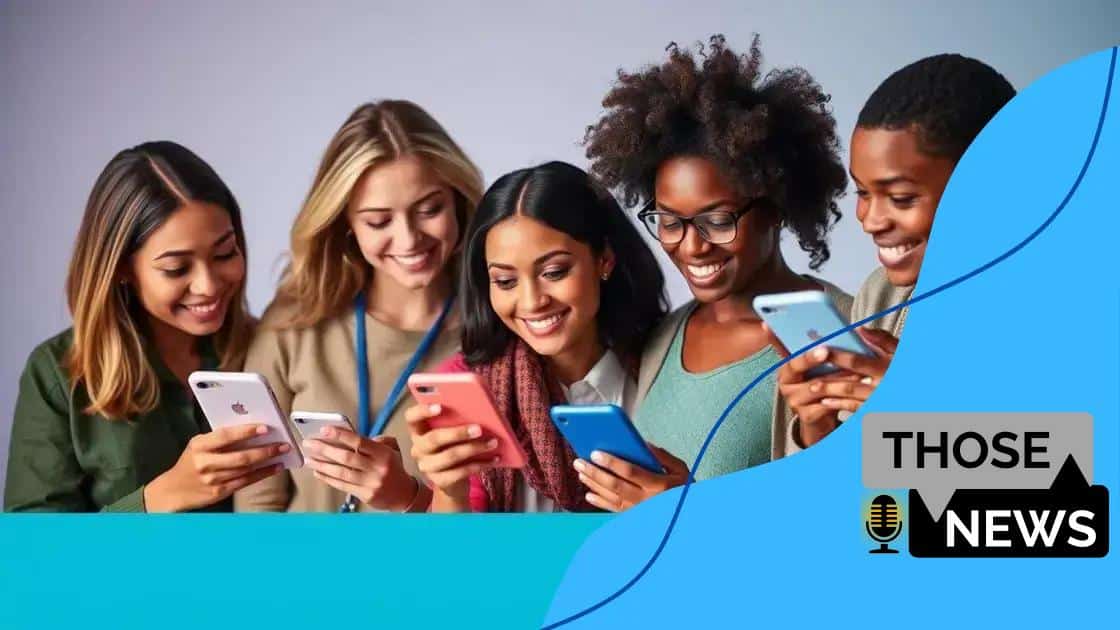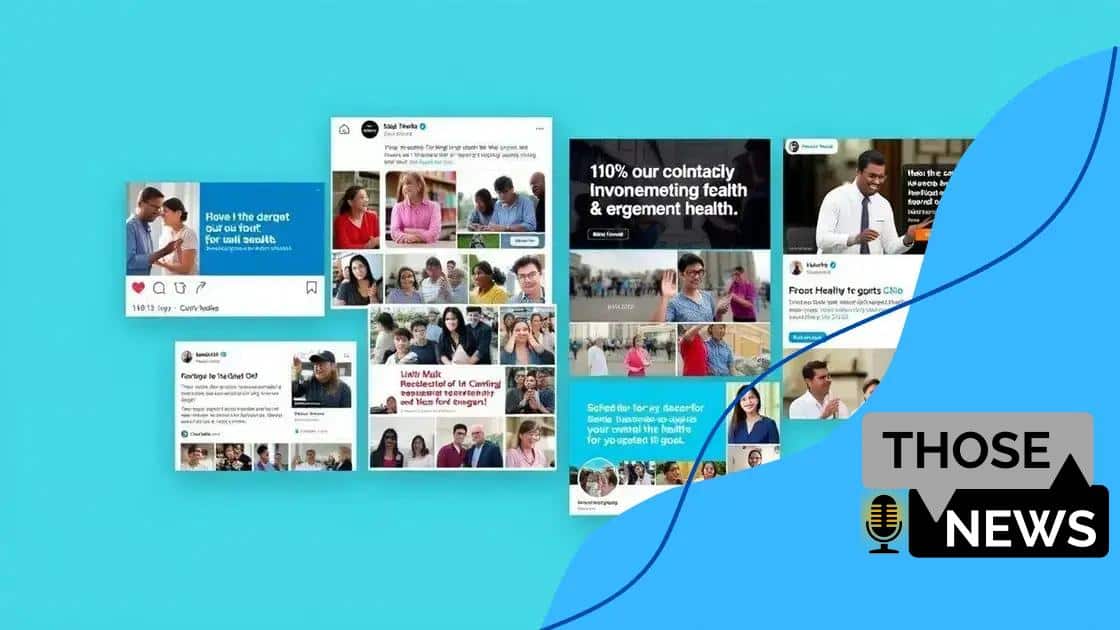Social media’s role in public health awareness

Social media plays a crucial role in public health awareness by disseminating clear, engaging information, leveraging visuals, and fostering community interactions, while also addressing misinformation and enhancing the credibility of health campaigns.
Social media’s role in public health awareness has become increasingly vital in today’s interconnected world. Have you noticed how these platforms shape our understanding of health issues? Let’s explore this fascinating intersection.
Understanding the impact of social media on health information
Understanding the impact of social media on public health is crucial, especially in today’s digital age. Social media platforms have transformed how we receive and share health information.
They are not just sites for connection; they serve as vital channels for disseminating health messages. Numerous studies show that a significant number of people rely on social media to get their health news.
The Benefits of Social Media in Health Information
Here are some key benefits:
- Rapid dissemination of information allows health organizations to reach a broader audience quickly.
- Engagement encourages discussions between healthcare professionals and the public.
- Accessibility provides marginalized communities with crucial health information.
Think about how fast a trending health topic can spread. Information that might take days or even weeks to reach the public through traditional media can be shared within minutes on social media. Health organizations are leveraging these platforms to spread awareness about various health issues quickly.
The Risks of Social Media in Health Information
Despite its advantages, social media also presents some challenges. Misinformation can spread just as fast as reliable information. Many users may not verify the sources of health information they come across. This can lead to confusion and potentially dangerous decisions.
It’s essential for users to critically evaluate the information they receive on these platforms. Checking for credible sources and expert opinions is crucial. By doing this, individuals can better navigate the vast sea of information available.
Additionally, many health campaigns have successfully harnessed social media’s power. They effectively educate the public about topics ranging from vaccination to mental health. With the right strategy, organizations can significantly enhance public understanding of health issues.
How social media changes public engagement in health
How social media shapes public engagement in health is an essential aspect of modern communication. With platforms like Facebook, Twitter, and Instagram, people are more connected than ever, and health discussions have entered our daily lives.
Social media provides a unique space for individuals to share their experiences and learn from others. These interactions can significantly influence public perceptions of health issues.
Increased Accessibility
One key benefit is increased accessibility. Health information that might have been difficult to find is now at our fingertips. People can engage in health conversations from the comfort of their homes. This engagement leads to a broader understanding of various health topics.
- Online communities connect individuals with similar health concerns.
- Health resources are now easily sharable and searchable.
- The diversity of voices helps highlight various perspectives.
Many users actively participate in these discussions, creating a more informed public. For example, social media campaigns can raise awareness for issues like mental health or nutrition in ways traditional media cannot.
Empowerment Through Sharing
Sharing personal stories on social media empowers others. When individuals see their peers discussing health challenges, they often feel less isolated. This visibility encourages open communication about health, reducing stigma associated with certain conditions.
Furthermore, health professionals use social media to engage with the public, providing expert opinions and guidance. This two-way communication enriches public understanding and fosters trust in health messaging.
Yet, it is crucial to be aware of the potential for misinformation. As the volume of information grows, so does the risk of false claims. Users must critically assess the information they encounter online through fact-checking and verifying sources.
Case studies of successful health campaigns on social media

Case studies of successful health campaigns on social media highlight the effectiveness of these platforms in spreading awareness and mobilizing communities. By analyzing various campaigns, we can see how strategic use of social media can enhance public health initiatives.
One notable example is the #IceBucketChallenge, which raised awareness for ALS. This viral campaign encouraged people to dump ice water on themselves and challenge friends to do the same, all while donating to ALS research. Its success lay in its ability to engage participants in a fun and impactful way.
Key Elements of Successful Campaigns
Successful health campaigns often share common characteristics that lead to their effectiveness.
- Engagement: Campaigns that invite public participation tend to capture more attention.
- Shareability: Content that is easy to share increases reach and visibility.
- Strong messaging: Clear and compelling messages resonate better with audiences.
Another successful campaign is the #StopTheSpread initiative during the COVID-19 pandemic. This campaign provided important information about safety protocols, encouraging individuals to wear masks and practice physical distancing. Leveraging the power of influencers, this campaign reached a vast audience and changed behaviors at a critical time.
Use of visuals also plays a crucial role in these campaigns. Infographics, videos, and memes can communicate important health information quickly and effectively. For instance, the World Health Organization (WHO) often shares infographics on social media to educate the public on health topics, making complex information accessible.
Challenges and Lessons Learned
While many campaigns have seen success, challenges remain. Misinformation can dilute campaign messages and lead to confusion. Learning from past mistakes and successes can pave the way for more effective future campaigns.
Maintaining authenticity is also vital. Audiences are more likely to respond to campaigns that feel genuine rather than overly commercialized. By focusing on real stories and relatable content, health organizations can foster trust and engagement among the public.
Challenges and risks of misinformation on social media
Challenges and risks of misinformation on social media pose significant threats to public health and safety. As many people turn to these platforms for health information, the spread of false or misleading content can lead to serious consequences.
One of the main challenges is the speed at which misinformation spreads. Social media algorithms often prioritize engaging content, which can include sensational or incorrect health claims. This rapid dissemination can confuse users and lead to harmful health decisions.
Identifying Misinformation
Recognizing misinformation is crucial for protecting public health. Here are some strategies to help identify it:
- Check the source: Always verify if the information comes from a credible organization or expert.
- Look for supporting evidence: Reliable information usually has data or studies to back it up.
- Beware of sensational language: Misinformation often uses alarmist or overly emotional language.
Using these tactics can empower individuals to be more critical consumers of health information online. Additionally, social media platforms are implementing measures to combat misinformation, such as fact-checking and flagging unreliable posts.
The Impact of Misinformation
The impact of misinformation can be widespread. For instance, the COVID-19 pandemic saw a surge in false information regarding treatments and vaccines. This not only created public confusion but also hindered health responses.
Misinformation can erode trust in health authorities. When people receive conflicting messages, they may become distrustful of legitimate health sources. Thus, it is crucial for health organizations to communicate clearly and consistently.
Efforts to address misinformation must be ongoing. Engaging the community in conversations about reliable health information can help bridge gaps in understanding. Education and awareness campaigns can build resilience against the tide of false claims.
Strategies for effective health messaging on social media
Strategies for effective health messaging on social media are crucial for reaching and engaging the public. In a world where many people rely on social platforms for health information, the way messages are crafted can significantly impact their effectiveness.
One effective strategy is using clear and simple language. Health topics can be complex, so breaking down information into easy-to-understand terms helps reach a wider audience. Avoiding jargon ensures that everyone can grasp the message being conveyed.
Visual Communication
Incorporating visuals is another important strategy. Infographics, images, and videos can capture attention and enhance understanding. People often remember visual content better than text alone. For instance, a short video demonstrating a health procedure can be more effective than a written description.
- Use of infographics: They summarize information in a visually appealing way.
- Storytelling: Sharing real stories can make messages relatable and impactful.
- Interactive content: Quizzes and polls can engage the audience actively.
Leveraging user-generated content is also powerful. Encouraging followers to share their experiences with health topics can create a sense of community. When people see others discussing their health journeys, it can inspire them to engage more deeply with the content.
Timing and Frequency
Timing and frequency are essential for effective health messaging. Posting at times when your target audience is most active increases the likelihood of engagement. Regularly updating content keeps the audience informed and creates a routine for viewers.
Monitoring engagement metrics can help refine strategies. By observing which posts resonate best with the audience, health organizations can adjust their messaging for better results. This kind of analysis allows for continuous improvement in outreach efforts.
Partnerships with influencers and healthcare professionals can amplify messages even further. Collaborating with trusted figures can lend credibility to health campaigns, making outreach more efficient. When influencers share accurate health information, they help bridge the gap between professionals and the public.
In summary, effective health messaging on social media is crucial for improving public awareness and engagement. By using clear language, visual content, and engaging strategies, health organizations can reach a wider audience. It is important to continuously refine messaging based on audience feedback and trends. Partnerships with influencers and healthcare professionals can enhance credibility and broaden the impact of health campaigns. Ultimately, the goal is to create a well-informed community that actively participates in their health decisions.
FAQ – Frequently Asked Questions about Health Messaging on Social Media
What is the importance of using clear language in health messaging?
Using clear language helps ensure that health information is easily understood by a wider audience, reducing confusion about important health issues.
How can visuals enhance health communication on social media?
Visuals like infographics and videos make complex information more accessible and engaging, helping people retain important health messages.
What role do influencers play in health campaigns?
Influencers can increase the credibility and reach of health messages by sharing accurate information with their followers, fostering trust in health initiatives.
How can health organizations measure the effectiveness of their social media strategies?
By analyzing engagement metrics such as likes, shares, and comments, organizations can determine what types of content resonate best with their audience and adjust their strategies accordingly.


